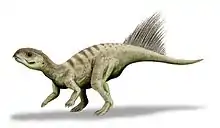Rubeosaurus
Rubeosaurus (meaning "bramble or thornbush lizard") is a potentially dubious genus of ceratopsian dinosaur which lived in what is now North America. Rubeosaurus fossils have been recovered from strata of the upper Two Medicine Formation of the Upper Cretaceous of Montana, dating to 74.6 million years ago.[1]
| Rubeosaurus | |
|---|---|
 | |
| Holotype specimen | |
| Scientific classification | |
| Kingdom: | Animalia |
| Phylum: | Chordata |
| Clade: | Dinosauria |
| Order: | †Ornithischia |
| Family: | †Ceratopsidae |
| Subfamily: | †Centrosaurinae |
| Clade: | †Eucentrosaura |
| Tribe: | †Centrosaurini |
| Genus: | †Rubeosaurus McDonald & Horner, 2010 |
| Type species | |
| †Rubeosaurus ovatus Gilmore, 1930 | |
| Species | |
| |
History of discovery
The holotype specimen, USNM 11869, is composed of a partial parietal and was discovered by George F. Sternberg in 1928.
This genus was named by Andrew T. McDonald and John R. Horner in 2010, and the type species is Rubeosaurus ovatus. Formerly this species was assigned to Styracosaurus.[2] It is notable for its large broad–based nasal horn and the ornamentation of its bony frill: there were one or two pairs of straight spikes on the edge, with the two spikes closest to the midline pointing so that they converged.[1] Immature specimens referred to a separate genus, called Brachyceratops, may be juvenile Rubeosaurus.[1][3]
Additional specimens

A second specimen, MOR 492, composed of a partial skull including a partial left premaxilla, co-ossified left and right nasals with horncore, partial left postorbital with horncore, and a nearly complete right parietal with two spikes, was discovered in 1986 and referred to R. ovatus in 2010.[1] A third, subadult specimen with very short frill spikes (USNM 14765) was referred in 2011.[4] However, subsequent studies suggested these specimens belonged to a distinct genus and species, Stellasaurus ancellae.[5]
In 2007, Michael J. Ryan and colleagues suggested that Brachyceratops was possibly the juvenile form of Rubeosaurus.[3] A 2011 study supported this idea for the most mature specimen of Brachyceratops, USNM 14765, which shows one unique newly evolved feature (apomorphy) in common with Rubeosaurus to the exclusion of other centrosaurines. However, the same study suggested that because the holotype specimen of Brachyceratops is too incomplete and juvenile to preserve any determinable apomorphies, Brachyceratops must be considered a nomen dubium, and cannot be a senior synonym of Rubeosaurus.[4]
Classification

The classification of Styracosaurus/Rubeosaurus ovatus as distinct from Styracosaurus albertensis was based both on differences in the arrangement of the frill spikes, as well as a phylogenetic analysis that suggested it was more closely related to the pachyrhinosaurs than to Styracosaurus and Centrosaurus. However, neither of these lines of evidence have generally been supported by more recent studies. For example, Chiba et al. (2017) recovered R. ovatus as the sister taxon of Styracosaurus.[6] Wilson et al. (2020) found the same result - while they recovered one previously assigned specimen as being closer to pachyrhinosaurs, it was not the Rubeosaurus holotype, an so they placed it in a third genus, Stellasaurus. They considered Rubeosaurus a synonym of Styracosaurus, as shown in their cladogram below:[5]
| Centrosaurinae |
| |||||||||||||||||||||||||||||||||||||||||||||||||||||||||||||||||||||||||||||||||||||||||||||||||||||||||||||||||||||
Holmes et al. (2020) argued further that the proposed diagnostic characters of Styracosaurus ovatus/Rubeosaurus fall within the range of asymmetry and individual variation found in Styracosaurus albertensis. The authors considered R. ovatus to be a junior synonym of Styracosaurus albertensis.[7] Another 2020 study describing a juvenile specimen of Styracosaurus further cast doubt on the usefulness of frill spike arrangement for classification. In that study, authors Caleb Brown, Robert Holmes, and Phillip Currie, concluded that the features used to differentiate S. ovatus were likely within the range of variation for the species S. albertensis. They pointed out that several specimens that are otherwise consistent with S. albertensis have been found with inward angled midline frill spikes, though not the same degree as S. ovatus. Given its slightly higher stratigraphic position and more angled spikes, they suggested that it may just be an "extreme morph" of S. albertensis.[8]
See also
References
- Andrew T. McDonald & John R. Horner, (2010). "New Material of "Styracosaurus" ovatus from the Two Medicine Formation of Montana". Pages 156–168 in: Michael J. Ryan, Brenda J. Chinnery-Allgeier, and David A. Eberth (eds), New Perspectives on Horned Dinosaurs: The Royal Tyrrell Museum Ceratopsian Symposium, Indiana University Press, Bloomington and Indianapolis, IN.
- Gilmore, Charles W. (1930). "On dinosaurian reptiles from the Two Medicine Formation of Montana". Proceedings of the United States National Museum. 77 (16): 1–39. doi:10.5479/si.00963801.77-2839.1.
- Ryan, Michael J.; Holmes, Robert; Russell, A.P. (2007). "A revision of the late Campanian centrosaurine ceratopsid genus Styracosaurus from the Western Interior of North America" (PDF). Journal of Vertebrate Paleontology. 27 (4): 944–962. doi:10.1671/0272-4634(2007)27[944:AROTLC]2.0.CO;2. Retrieved 2010-08-19.
- McDonald, A. T. (2011). Farke, Andrew Allen (ed.). "A Subadult Specimen of Rubeosaurus ovatus (Dinosauria: Ceratopsidae), with Observations on Other Ceratopsids from the Two Medicine Formation". PLoS ONE. 6 (8): e22710. doi:10.1371/journal.pone.0022710. PMC 3154267. PMID 21853043.
- Wilson, John P.; Ryan, Michael J.; Evans, David C. (2020). "A new, transitional centrosaurine ceratopsid from the Upper Cretaceous Two Medicine Formation of Montana and the evolution of the 'Styracosaurus-line' dinosaurs". Royal Society Open Publishing. 7 (4). doi:10.1098/rsos.200284.
- Kentaro Chiba; Michael J. Ryan; Federico Fanti; Mark A. Loewen; David C. Evans (2018). "New material and systematic re-evaluation of Medusaceratops lokii (Dinosauria, Ceratopsidae) from the Judith River Formation (Campanian, Montana)". Journal of Paleontology. in press. doi:10.1017/jpa.2017.62.
- Robert.B. Holmes; Walter Scott Persons; Baltej Singh Rupal; Ahmed Jawad Qureshi; Philip J. Currie (2020). "Morphological variation and asymmetrical development in the skull of Styracosaurus albertensis". Cretaceous Research. 107: Article 104308. doi:10.1016/j.cretres.2019.104308.
- Brown, C., Holmes, R., & Currie, P. J. (2020). A subadult individual of Styracosaurus albertensis (Ornithischia: Ceratopsidae) with comments on ontogeny and intraspecific variation in Styracosaurus and Centrosaurus. Vertebrate Anatomy Morphology Palaeontology, 8(1), 67-95. https://journals.library.ualberta.ca/vamp/index.php/VAMP/article/view/29361
| Wikimedia Commons has media related to Rubeosaurus. |





